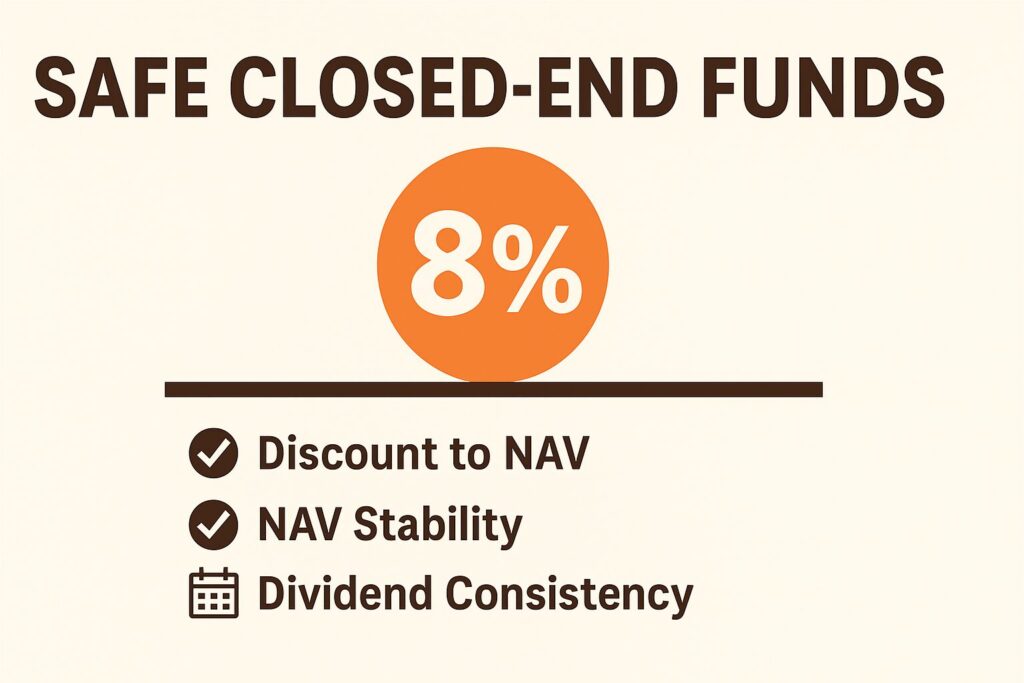
Simple tools and tips to help retirees find high-yield income—without unnecessary risk.
Closed-end funds (CEFs) can be a hidden gem for retirees seeking steady, high-yield income. While traditional bonds or dividend stocks might yield 3–5%, a well-chosen CEF can generate 8% or more in annual income—often paid monthly.
But not all CEFs are safe. Some are loaded with leverage, have unstable net asset values (NAV), or rely on risky strategies to sustain their payouts.
The good news? You don’t need to be an expert to screen for reliable CEFs. In this post, you’ll learn how to find safer, higher-yielding closed-end funds by looking at three essential factors:
- Discounts to NAV
- NAV stability
- Long-term dividend consistency
We’ll also share three free tools retirees can use to evaluate CEFs with confidence.
✅ What Is a Closed-End Fund (CEF)?
A CEF is a publicly traded investment fund that raises a fixed pool of capital and invests it in a portfolio of income-generating assets—such as bonds, preferred stocks, dividend stocks, or senior loans.
Unlike mutual funds or ETFs, CEFs have a fixed number of shares, so they often trade at a premium or discount to their net asset value (NAV).
This structure creates opportunities for savvy income investors—but also potential pitfalls for those who buy blindly.
✅ Step-by-Step: How to Pick a Safe 8% CEF
Step 1: Look for a Discount to NAV
The NAV is what the fund’s holdings are worth. If the market price of the CEF is lower than its NAV, you’re buying the fund at a discount—getting more assets (and income) for your dollar.
✅ Tip: Prefer CEFs trading at a 5%–15% discount to NAV.
Step 2: Check NAV Stability
CEFs that consistently maintain or grow their NAV (Net Asset Value) over time are likely managing risk well and supporting their payouts with real earnings—not just return of capital.
✅ Tip: Use 3–5 year NAV trend charts. Avoid funds with steady NAV erosion, even if the yield is high.
Step 3: Evaluate Dividend History
Look for funds that have paid consistent or growing dividends over the past several years—especially through tough markets. Be wary of funds that have a history of frequent cuts.
✅ Tip: Focus on funds with stable payouts for at least 5 years and a track record through down markets.
✅ Three Free CEF Screening Tools for Retirees
You don’t need fancy software to screen for CEFs. Here are three reliable, easy-to-use resources:
- CEFConnect.com
A go-to for income investors, CEFConnect offers detailed fund data including yield, NAV, discount/premium, leverage, and distribution history. - Morningstar.com
Offers basic CEF data plus analyst commentary and star ratings. Great for comparing funds side by side. - CEFData.com
Offers screener tools and analytics for more advanced users. Good for identifying trends in NAV performance and dividend coverage.
✅ Real-Life Example: Finding a Safe 8% CEF
Susan, a 70-year-old retiree, wanted to earn higher monthly income from her IRA. She used CEFConnect to screen for funds yielding over 8%, trading at a discount, and with stable NAVs over the past 5 years.
She narrowed it down to UTG (Reaves Utility Income Fund)—a conservative fund focused on utility stocks and infrastructure, yielding around 8%.
Today, Susan earns monthly income while sleeping well at night, knowing her fund has a long history of steady payouts and conservative management.
✅ The Bottom Line
A safe 8% yield may sound too good to be true—but with closed-end funds, it’s not only possible, it’s practical.
The key is to avoid yield traps by screening for:
- NAV discounts
- NAV stability
- Long-term dividend reliability
With a few free tools and a focus on quality, you can build a portfolio of CEFs that pays you well—without putting your retirement at risk.
📘 This post is adapted from my book:
The 8% Solution: Double Your Retirement Income With High-Yield Closed-End Funds,
Available now at Amazon.com in paperback and eBook formats.
Inside, you’ll find everything you need to know to build a diversified, high-income portfolio with safe, proven CEFs.
⚠️ Disclaimer
This content is for informational and educational purposes only and does not constitute financial, investment, or tax advice. Investing involves risk, including the possible loss of principal. Always consult a qualified financial advisor before making investment decisions. The author is not a registered financial professional and does not provide personalized investment advice.